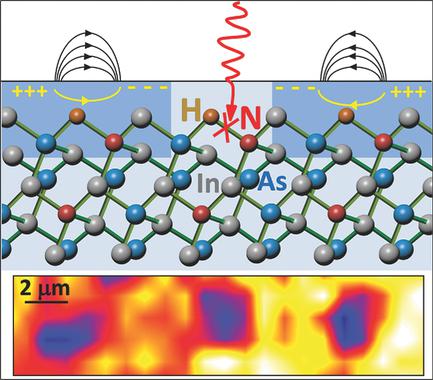当前位置:
X-MOL 学术
›
Adv. Opt. Mater.
›
论文详情
Our official English website, www.x-mol.net, welcomes your
feedback! (Note: you will need to create a separate account there.)
Optical Detection and Spatial Modulation of Mid‐Infrared Surface Plasmon Polaritons in a Highly Doped Semiconductor
Advanced Optical Materials ( IF 8.0 ) Pub Date : 2017-12-28 , DOI: 10.1002/adom.201700492 Davide Maria Di Paola 1 , Anton V. Velichko 1 , Mario Bomers 2 , Nilanthy Balakrishnan 1 , Oleg Makarovsky 1 , Mario Capizzi 3 , Laurent Cerutti 2 , Alexei N. Baranov 2 , Manoj Kesaria 4 , Anthony Krier 4 , Thierry Taliercio 2 , Amalia Patanè 1
Advanced Optical Materials ( IF 8.0 ) Pub Date : 2017-12-28 , DOI: 10.1002/adom.201700492 Davide Maria Di Paola 1 , Anton V. Velichko 1 , Mario Bomers 2 , Nilanthy Balakrishnan 1 , Oleg Makarovsky 1 , Mario Capizzi 3 , Laurent Cerutti 2 , Alexei N. Baranov 2 , Manoj Kesaria 4 , Anthony Krier 4 , Thierry Taliercio 2 , Amalia Patanè 1
Affiliation

|
Highly doped semiconductors (HDSCs) are promising candidates for plasmonic applications in the mid‐infrared (MIR) spectral range. This work examines a recent addition to the HDSC family, the dilute nitride alloy In(AsN). Postgrowth hydrogenation of In(AsN) creates a highly conducting channel near the surface and a surface plasmon polariton detected by attenuated total reflection techniques. The suppression of plasmonic effects following a photoannealing of the semiconductor is attributed to the dissociation of the NH bond. This offers new routes for direct patterning of MIR plasmonic structures by laser writing.
中文翻译:

高掺杂半导体中中红外表面等离激元极化子的光学检测和空间调制
高掺杂半导体(HDSC)是中红外(MIR)光谱范围内等离子应用的有前途的候选者。这项工作研究了HDSC系列的最新成员,即稀氮化物合金In(AsN)。In(AsN)的生长后氢化在表面附近创建了一个高传导通道,并通过衰减全反射技术检测到了表面等离子体激元极化。的以下的半导体的photoannealing等离子体效应抑制归因于所述N个的解离 H键。这提供了通过激光写入直接图案化MIR等离子体结构的新途径。
更新日期:2017-12-28
中文翻译:

高掺杂半导体中中红外表面等离激元极化子的光学检测和空间调制
高掺杂半导体(HDSC)是中红外(MIR)光谱范围内等离子应用的有前途的候选者。这项工作研究了HDSC系列的最新成员,即稀氮化物合金In(AsN)。In(AsN)的生长后氢化在表面附近创建了一个高传导通道,并通过衰减全反射技术检测到了表面等离子体激元极化。的以下的半导体的photoannealing等离子体效应抑制归因于所述N个的解离 H键。这提供了通过激光写入直接图案化MIR等离子体结构的新途径。











































 京公网安备 11010802027423号
京公网安备 11010802027423号